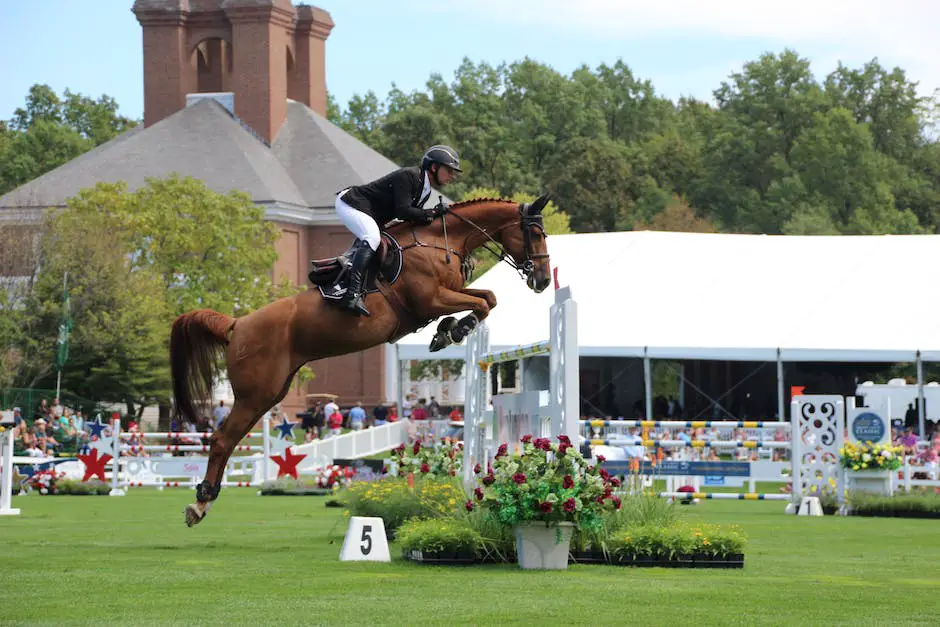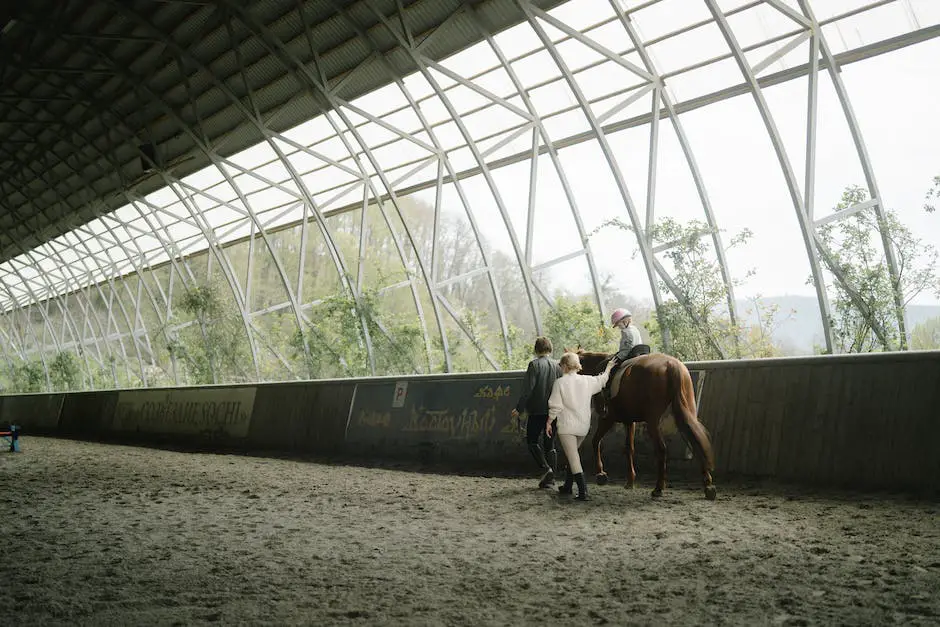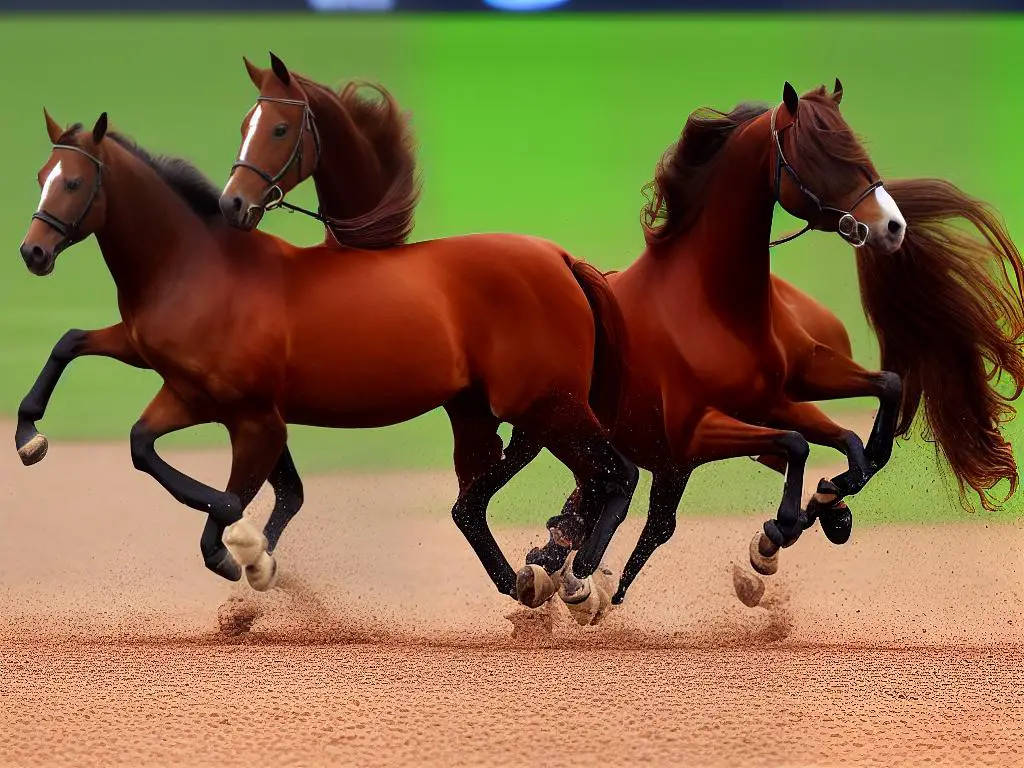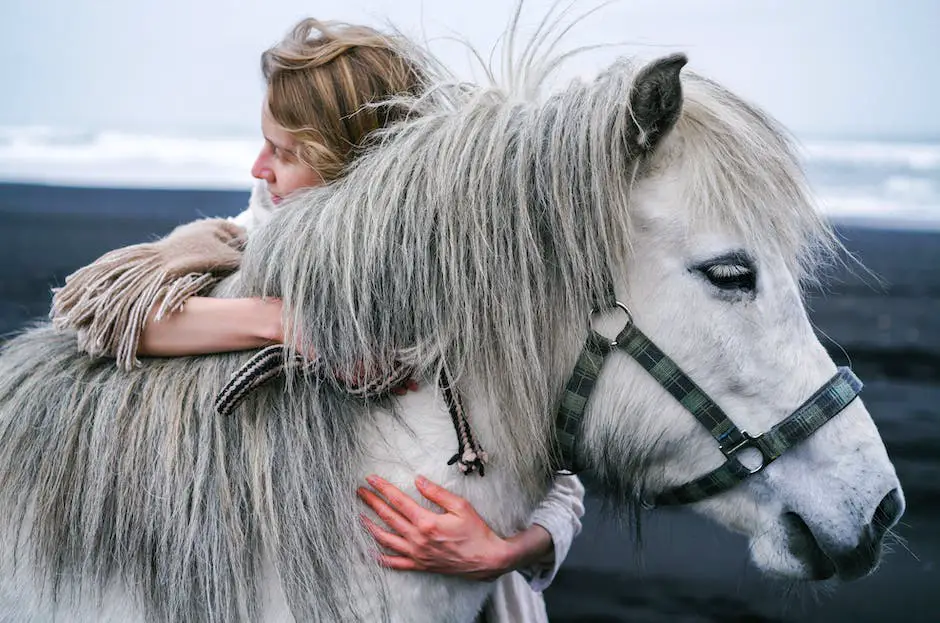Saddlebred horse shows are a captivating and exhilarating world, showcasing the beauty, elegance, and athleticism of these exceptional equines. From their rich history to the intricacies of training, grooming, and competing, this fascinating equestrian discipline offers a wealth of opportunities for enthusiasts and hobbyists to become deeply immersed in its unique culture. As you delve into the various aspects of Saddlebred horse shows, prepare to discover a rich and vibrant community, unparalleled equine talent, and abundant knowledge to help you excel in this entrancing pursuit.
Table of Contents (Horspedia)
History of Saddlebred Horse Shows
The history of Saddlebred horse shows in the United States begins in the early 19th century when breeders started developing a high-stepping, versatile breed that eventually became known as the American Saddlebred. These horses were bred to be showy, agile, and able to perform a variety of gaits under saddle, making them ideal for competitions.
As the breed’s popularity grew, horse shows began to include classes specifically designed to showcase the unique talents of the American Saddlebred.
Throughout the 19th and early 20th centuries, Saddlebred horse shows provided a social and competitive outlet for the breed’s enthusiasts. As horse shows evolved into organized events, various classes were established to differentiate horses performing in different gaits, such as the slow gait, the rack, and the trot. The rich tradition of breeding and showing Saddlebreds was especially strong in the South, particularly in Kentucky, and many prestigious shows emerged during this period.
One of the most significant events in Saddlebred horse show history was the founding of the American Saddle Horse Breeders’ Association (now the American Saddlebred Horse Association) in 1891. This association was created to establish a registry for the breed, promote the showing of Saddlebred horses, and maintain a standard for the ideal American Saddlebred. Today, the ASHA remains dedicated to preserving the history and promoting the future of the breed, with the World’s Championship Horse Show held annually in Louisville, Kentucky as its marquee event.
Over the years, several sub-disciplines have emerged within Saddlebred horse shows, catering to the various talents and styles of the breed. Some of the most popular types of classes include pleasure, park, and performance classes, as well as three-gaited, five-gaited, and fine harness classes. Additionally, Saddlebred horse shows frequently include equitation classes, which focus on the skill and form of the rider.
As both an enthusiast and a hobbyist, exploring the world of Saddlebred horse shows is a fascinating journey into the world of equestrian sports. With competitions held across the United States and even expanding into international markets, Saddlebred horse shows are a true testament to the dedication, passion, and talent within the community. Embracing modern techniques and technologies, enthusiasts work tirelessly to advance the breed and ensure a promising future for this uniquely American horse.

Photo by josephineamaliepaysen on Unsplash
Saddlebred Horse Breeds and Bloodlines
Delving deeper into the history of the American Saddlebred horse reveals a beautiful and versatile breed that traces its roots back to the early American colonies. Originating from the Narragansett Pacer, the Saddlebred is a unique blend of Thoroughbred, Morgan, and Standardbred bloodlines. Known for their elegance, athleticism, and amiable disposition, the Saddlebred has secured its place in equestrian history and has become a popular choice among both competitive and recreational riders. As you immerse yourself in the world of Saddlebred horse shows, you’ll discover an exciting and thriving breed that promises to remain a significant part of equestrian sports for generations to come.
The breed is known for its distinctive high-stepping gaits, which are natural and expressive movements that capture the attention of audiences at Saddlebred horse shows. Saddlebreds are known to perform three or five gaits, depending on their specific training. The three-gaited Saddlebred performs the walk, trot, and canter, while the five-gaited horse adds two additional gaits – the slow gait and the rack. These unique gaits highlight the breed’s grace and power, making them a magnet for horse show enthusiasts.
Saddlebred horses exhibit a variety of colors, including chestnut, bay, black, gray, and palomino. Some individuals may also display unique markings like chrome, white stockings or blazes on their faces. In addition to their distinctive gaits and colorful coats, the breed standard for the Saddlebred emphasizes their well-proportioned conformation. A long, elegant neck, strong back, and powerful shoulders are hallmark physical characteristics of the breed. These physical traits give the Saddlebred a majestic presence, both in the show ring and out.
Throughout history, Saddlebred horses have been bred with great attention to bloodlines, which contributes to the consistent quality of the breed. One bloodline that has made a significant impact on the breed is that of the great foundation sire, Denmark. Bred in the mid-1800s, Denmark and his offspring have had a lasting influence on the development of the modern Saddlebred. Today, many of the top Saddlebred show horses can trace their lineage back to this exceptional stallion.
Within the American Saddlebred breed, there are numerous bloodlines, each with its specific attributes and strengths. Some bloodlines emphasize athleticism, while others may highlight the horse’s amiable disposition or flashy appearance. Breeding programs dedicated to consistently producing high-quality horses for Saddlebred horse shows ensure these desirable traits are fostered. As a result, the American Saddlebred continues to be a beloved breed, both in the show ring and among horse enthusiasts across the country.

Show Disciplines and Divisions
Five-Gaited Horse Shows
Building off these strong bloodlines, the popular and thrilling Five-Gaited category showcases the Saddlebred’s exceptional abilities in various horse shows. In this division, horses are expected to perform the five gaits, which include the walk, trot, canter, slow gait, and rack. Each gait is performed at natural, collected, and extended speeds. Saddlebred horses excel in these gaits due to their expressive leg action and overall elegance. Judges typically score horses based on manners, performance, presence, quality, and conformation while evaluating all the various speeds of gaits. The Five-Gaited category is a great way for horse enthusiasts to witness the majesty and skill of the American Saddlebred in action.
Three-Gaited Horse Shows
Another integral category in Saddlebred horse shows is the Three-Gaited division. In these classes, the horse performs only the walk, trot, and canter, without demonstrating the slow gait and rack seen in the Five-Gaited division. Horses are shown with a full mane and tail, and their animation and elegance are highlighted throughout the performance. The Three-Gaited division is further divided into amateur, junior exhibitor, and open classes. Each sub-category helps to ensure that horses compete with others of similar skill levels and experience.
Pleasure Class
One versatile division available in Saddlebred horse shows is the Pleasure class. This division showcases horses with good manners, a comfortable ride, and that are considered enjoyable to both ride and watch. Pleasure horses are judged on a combination of performance, manners, presence, and overall pleasantness in the show ring. Within the Pleasure division, there are several subclassifications, such as Country Pleasure and Show Pleasure classes. The Country Pleasure class exhibits horses that are well-behaved and suitable for country trail rides, while Show Pleasure horses display a higher level of animation and showiness.
Park Class
Park classes are another popular category within Saddlebred horse shows. These classes showcase Saddlebred horses that have elegant, high-stepping action, and are typically shown in three-gait and five-gait classes. In Park classes, horses carry themselves with a natural, forward-moving attitude, and judges look for a balanced, smooth performance that showcases the horse’s athleticism. This division is often considered a middle ground between the more extreme action seen in performance divisions like the Five-Gaited and the more subdued Pleasure classes.
Other Divisions and Classes
In addition to the main divisions previously mentioned, the Saddlebred horse show world features a variety of disciplines and specialized classes. Examples of these include the Fine Harness class, where horses are shown in a four-wheeled vehicle and driven by the exhibitor; the Roadster class, which showcases extreme speed and athleticism as horses perform the trot and road gait; and the Western Pleasure category, which assesses the suitability of Saddlebred horses for Western riding styles. Additionally, age-specific classes, equitation classes focused on the rider’s skills, and numerous others, demonstrate the versatility and adaptability of Saddlebred horses.

Training and Preparation
Training and preparation play vital roles in readying a Saddlebred horse for competition in these diverse show classes. Building a strong foundation through basic groundwork, such as lunging and long-lining, is crucial before progressing to under-saddle work. Moreover, incorporating strength and flexibility exercises like lateral movements and transitions between gaits helps develop proper muscle tone for the horse. Since Saddlebred horses are known for their elegant, elevated trot and balanced canter, it’s essential to include these gaits in the horse’s training regime and focus on developing mastery across the various disciplines they will compete in.
Conditioning regimens for Saddlebred horse shows involve a combination of cardiovascular and strength training to ensure that the horse is fit and agile. This typically includes consistent workout sessions of at least five days a week, ranging from 30 minutes to an hour, alternating between aerobic and anaerobic exercise. For example, long, slow distance work helps build stamina and should be accompanied by interval training with speed play and bursts of intense work. Riding hills or incorporating cavalletti within training sessions are other options for building fitness, as they engage the horse’s hind end and increase overall balance and engagement.
Consulting with a professional Saddlebred trainer can provide valuable insights and tailored advice for each individual horse. These experienced professionals have a deep understanding of the breed-specific requirements for Saddlebred horse shows and can help identify and address any training challenges or areas for improvement. They can also provide guidance on the ideal training schedule and techniques to use, as well as advice on nutrition and management to ensure optimal physical and mental well-being during show season.
Presentation is a vital aspect of Saddlebred horse shows, and working with the horse on their show day behavior is crucial. Practice in-hand showing techniques, such as leading, standing, and setting up the horse in a square stance to demonstrate their conformation, as these will be required in halter or model classes. Additionally, teaching the horse to calmly approach and navigate in-gate areas, pass other horses in close quarters, and stand quietly during line-ups can help them feel more at ease during the competition. Exposure to show environments, such as through schooling shows or mock competitions, can also assist in acclimating the horse to the sights and sounds they will experience at a Saddlebred horse show.
Ensuring a Saddlebred horse’s success in competition requires regular assessments of their progress, as well as grooming and turnout to showcase their beauty and elegance. By closely monitoring the horse’s physical condition, attitude, and willingness to perform, as well as seeking guidance from experienced trainers, handlers can work towards achieving competition goals while prioritizing the health and happiness of the horse.

Grooming and Turnout
Grooming and turnout are essential components of Saddlebred horse shows, as they not only showcase the beauty and elegance of the horse but also reflect the attention to detail of the exhibitor. Proper grooming techniques start with a thorough brushing using a curry comb or stiff brush, which not only removes dirt and debris but also excites the natural oils for a healthy and shiny coat. Additionally, regularly using a mane and tail brush helps to prevent tangles, matting, and breakage. Clipping the bridle path, ears, and whiskers ensures a refined and neat appearance. Before the show, the horse should be bathed with a mild shampoo to remove deep-seated dirt and sweat, followed by a thorough rinse and towel-dry to bring out a gleaming coat.
The correct tack and equipment for Saddlebred horse shows enhance the horse’s appearance and allow for optimal performance. The bridle used for Saddle Seat classes should be a double bridle with two bits – a curb bit and a snaffle bit. The color of the tack should be of good quality leather and should match the horse’s coat color, with black tack common for most horses. The saddle should be a flat cutback saddle, designed specifically for the Saddlebred breed. This saddle allows for more extended movement than a regular English saddle. Keeping all tack clean and well-maintained is crucial, ensuring it is properly fitted to avoid discomfort or injury to the horse.

Show Day Tips and Guidelines
One of the most important aspects of preparing for a Saddlebred horse show is ensuring your horse is in top physical condition. Regular exercise and schooling are key to building the strength, balance, and agility necessary for a successful performance. It is crucial to have a consistent training program to develop and refine the skills required for show ring success, such as flying lead changes, smooth transitions, and precise lateral movements. Seek guidance from a professional trainer or experienced Saddlebred exhibitor to help tailor your program to your horse’s unique needs and abilities.
Appropriate attire for Saddlebred horse shows depends on the specific class being entered. However, there are general guidelines to ensure the rider appears polished and well-presented in the show ring. Female riders typically wear a conservative, tailored riding suit or day coat, while male riders wear a suit with a tie or dress shirt with a tie and dress pants. A derby or soft hat is often worn by both male and female riders, with black leather riding gloves and jodhpur boots. Colors should be kept conservative, typically with dark suits and white or off-white shirts. The attire should complement the horse without detracting from its appearance or drawing attention away from its performance.
The proper grooming and presentation of Saddlebred horses demonstrate the owner or exhibitor’s dedication to their horse’s welfare, appearance, and performance in the show ring. Consistent and thorough grooming techniques, immaculate tack and equipment, and polished rider attire underscore the elegance and beauty of the Saddlebred breed in competition. Attention to these details ensures a successful and rewarding experience for both the horse and rider in Saddlebred horse shows. A well-turned-out Saddlebred and appropriately dressed rider make a strong and lasting impression on judges and spectators alike. Grooming should be an integral part of a horse and rider’s routine to maintain a high level of cleanliness, comfort, and appearance for both. Following appropriate guidelines for grooming, equipment, and attire will highlight the Saddlebred’s natural beauty and astounding abilities while exemplifying the rider’s commitment and pride in their equine partner.
Proper grooming and presentation are paramount for making a positive impression on the judges and spectators. Show day grooming, including regular bathing, mane and tail care, and trimming or clipping excess hair, is essential for projecting a clean, polished appearance. Proper use of grooming products, such as coat conditioners, detanglers, and shine-enhancing sprays, can help enhance your horse’s natural beauty and add an extra touch of finesse to your overall presentation. Selecting appropriate riding attire, following breed standards and show division guidelines, is essential in demonstrating professionalism and commitment to the Saddlebred community.
Familiarizing yourself with the showgrounds, schedule, and specific show rules is vital for a smooth and enjoyable show day. Arrive at the event with ample time to acclimate your horse to the new environment, allowing time for schooling and warm-up in the arena. Review the show schedule and competition requirements, ensuring you have a clear understanding of your specific class specifications and judging criteria. Knowing what to expect will allow you to focus on giving your best performance with confidence and ease.
Another crucial factor for success is maintaining a positive and supportive atmosphere throughout the show day. Keep in mind that horse shows are a learning experience for both horse and rider – setbacks and mistakes are part of the journey. Maintain open lines of communication with your trainer, fellow exhibitors, and show personnel to foster a sense of camaraderie and mutual encouragement. Remembering that your primary goal is to develop your skills and showcase your horse’s talents, rather than winning at all costs, can help keep things in perspective and keep the show fun and enjoyable for everyone involved.
After the show, take the time to review and debrief on your performance, reflecting on areas where you excelled and identifying areas for improvement. Use your show experience as an opportunity to learn and grow, incorporating feedback from your trainer, judges, and fellow competitors to refine your skills and further develop your partnership with your Saddlebred horse. Most importantly, take some time to celebrate your successes and acknowledge the hard work and dedication that you and your horse have invested in preparing for the show. Maintaining a balanced perspective that emphasizes continuous learning and progress will serve you well as you continue to grow and develop in the exciting world of Saddlebred horse shows.

Photo by anthonydelanoix on Unsplash
Understanding Judging Criteria
As you further immerse yourself in this exciting world, a crucial aspect to consider is understanding the judging criteria at Saddlebred horse shows. This knowledge will not only enhance your appreciation of the levels of performance displayed by both horses and riders, but also give you insights into the scores and placings awarded. The primary goals of Saddlebred judging are to evaluate and reward correct overall form, balance, and self-carriage, along with the smoothness, style, and animation in movement. As an enthusiast or hobbyist, recognizing these elements will improve your experience at the show and contribute to your ongoing growth and development in this fascinating equestrian discipline.
The evaluation process involves judges examining both the horse and rider in several areas such as appearance, performance, manners, and presence. For the Saddlebred horse, attention is given to its way of going, expression, headset, and overall conformation. Its high-stepping, elegant movement, and flashy appearance are significant factors in determining its success in the show ring. In most Saddlebred classes, additional attributes such as stamina, drive from the legs, and consistency of gaits are also considered by the judges to ensure a complete assessment of the horse’s performance.
Riders, on the other hand, are judged on their equitation skills, which encompasses their posture, ability to effectively communicate with the horse, and their overall harmony with the horse’s movement. This evaluation is crucial in ensuring that riders not only look their best in the show ring, but also effectively showcase the horse’s talents and abilities. A rider with excellent equitation skills can elevate the performance of their Saddlebred and boost their chances of securing top placings in competitions.
Interpreting scores and placings in Saddlebred horse shows can appear complex initially, but it becomes clearer with a proper understanding of the judging criteria. In general, judges award scores based on their subjective interpretations of the horse and rider’s performance in various categories such as conformation, gaits, presentation, and manners. Placings are then determined by the cumulative scores awarded by the panel of judges, with ties typically broken by referring to the individual judge’s scores in specific categories.
As a Saddlebred horse show enthusiast, it’s crucial to familiarize oneself with the rules and guidelines established by organizations like the United States Equestrian Federation (USEF) and the American Saddlebred Horse Association (ASHA). These organizations set specific criteria for various Saddlebred classes, including performance, fine harness, pleasure, equitation, and in-hand. Attending horse shows, observing judging procedures, and engaging with experienced competitors or trainers can provide invaluable insights into the judging standards for Saddlebred horse shows.

Promoting and Marketing Your Saddlebred Horse
Once you have a solid grasp on Saddlebred horse show standards, it’s essential to focus on promoting and marketing your show horse effectively. Adopting a multifaceted approach can help ensure success in this arena. Strategies to consider include networking with fellow enthusiasts, considering breeding opportunities, and seeking sponsorships to enhance your horse’s visibility and value within the competitive Saddlebred horse community.
Networking
Networking with fellow Saddlebred enthusiasts can lead to increased exposure for your horse, as well as valuable professional connections within the industry. Attending high-profile events, expos, and clinics can provide an opportunity to showcase your horse and exchange information, tips, and contacts with other professionals.
Breeding Considerations
Quality bloodlines can automatically elevate the status of your Saddlebred, increasing its desirability for breeding and show purposes. Additionally, winning or placing in recognized shows will enhance your horse’s marketability and potential for lucrative breeding contracts. Use your horse’s lineage in promotional materials to capture the attention of potential buyers and breeders.
Digital Platforms
Social media, dedicated websites, and video content can all contribute to showcasing the unique qualities of your horse and attract the eyes of potential buyers, breeders, and sponsors. Consider collaborating with a professional photographer or videographer to create high-quality content.
Sponsorships
Seeking sponsorship opportunities can benefit both you and your sponsor. Research equestrian industry stakeholders, and propose arrangements that provide value to both parties. Sponsorships can introduce your horse to a larger audience, boosting your promotional efforts.
Exceptional Horsemanship
For enthusiasts and hobbyists looking to become skilled in Saddlebred horse shows, showcasing exceptional horsemanship, training, and care is crucial. Ensuring your horse is well-prepared for events, presented with impeccable grooming and presentation, and behaving professionally at all times is essential. A successful show horse will naturally draw attention, boosting their reputation and overall marketability.

Resources and Further Education
To further immerse yourself in the world of Saddlebred horse shows, it’s important to take advantage of resources like the American Saddlebred Horse Association (ASHA). Serving as both a registry and an education resource for everything related to the breed, the ASHA website offers a wealth of information on Saddlebred history, show schedules, competition results, and more. Additionally, the ASHA provides various educational programs and seminars throughout the year, designed to foster a greater understanding and appreciation of this remarkable breed.
Another valuable resource is the United States Equestrian Federation (USEF), the national governing body for equestrian sports in the United States. The USEF offers a Learning Center, which provides a variety of educational resources such as articles, videos, and webinars dedicated to the Saddlebred discipline. Their online portal enables members to stay up-to-date on the latest industry news, including rule changes, competition results, and upcoming events. Moreover, the USEF offers a range of membership benefits, such as discounts on services and products related to competition and horse care.
Saddlebred-specific publications also serve as excellent resources for individuals hoping to deepen their knowledge and involvement in the Saddlebred horse show world. Publications such as the Saddle & Bridle Magazine and the American Saddlebred Daily provide comprehensive coverage of Saddlebred news, show results, and features on prominent individuals and horses in the industry. By staying informed and engaged with these publications, enthusiasts have the opportunity to better understand trends, learn from the experiences of others, and network within the Saddlebred community.
Participation in local and regional events is a fantastic way to get hands-on experience and education in the Saddlebred horse show world. Many regions have specific Saddlebred associations, such as the New England, Mid-Atlantic, and Midwest Saddlebred Associations, which organize events, clinics, and educational opportunities catering specifically to their geographic area. By joining and attending events hosted by these organizations, enthusiasts can gain invaluable practical knowledge and network with other like-minded individuals.
In addition to these resources, aspiring Saddlebred horse show competitors can benefit from professional training and education to improve their skills. Many experienced trainers offer private lessons, workshops, and clinics specifically tailored to the Saddlebred discipline. These opportunities provide a unique chance to learn directly from accomplished industry professionals, honing essential skills, techniques, and strategies necessary to excel in the Saddlebred horse show world. Through continued education, network-building, and immersion in the available resources, enthusiasts will find themselves well on their way to becoming skilled competitors in the exciting world of Saddlebred horse shows.

Embarking on the journey of Saddlebred horse shows is truly a rewarding and enriching experience. With a dedicated approach to learning and passion for the spectacular artistry of these equine athletes, you’ll find countless opportunities to grow and thrive within this captivating equestrian community. By understanding the intricacies of Saddlebred horse breeds, honing your training and grooming skills, and acclimating to the rhythm of show day, you’ll undoubtedly discover a thrilling and fulfilling world where the bond between horse and rider is celebrated and cherished.